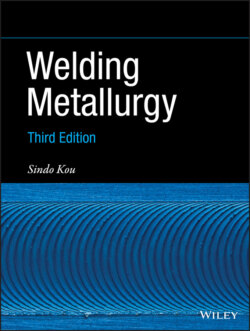Читать книгу Welding Metallurgy - Sindo Kou - Страница 14
1.1.1.1 Power Density of Heat Source
ОглавлениеIn fusion welding except for RSW, the power density is the power of the heat source divided by its cross‐sectional area at the workpiece surface. Consider directing a 1.5‐kW hair drier very closely to a 304 stainless steel sheet 0.25 mm thick. Obviously, the power spreads out over an area of roughly 50 mm diameter or greater, and the sheet just heats up gradually but will not melt. With GTAW at 1.5 kW, however, the arc can concentrate on a small area of about 5 mm diameter and can produce a weld pool. This example illustrates the importance of the power density of the heat source in welding.
As shown schematically in Figure 1.1, the size of the heat source increases from high‐energy beam welding to arc welding and to gas welding. The power density of the heat source and hence its ability to melt and weld deep decrease in the same order. As shown in Figure 1.2, as the power density of the heat source increases, the amount of heat absorbed by the workpiece before welding is completed decreases. A gas flame tends to heat up the workpiece so slowly that, before any melting occurs, a large amount of heat is already conducted away into the bulk workpiece. Excessive heating can damage the workpiece, weakening and distorting it. Contrarily, the same material heated by a sharply focused electron or laser beam can melt or even vaporize to form a deep keyhole instantaneously. This allows welding to be completed before much heat is conducted away into the bulk workpiece to cause any damage [1].
Figure 1.1 The size of the heat source and its effect on welding.
Figure 1.2 Heating of and hence damage to workpiece vs. power density of heat source.
Therefore, the advantages of increasing the power density of the heat source include deeper weld penetration, higher welding speed, and better weld quality with less damage to the workpiece, as indicated in Figure 1.2. Figure 1.3 shows that the weld strength (of aluminum alloys) increases as the heat input per unit length of the weld per unit thickness of the workpiece decreases [2]. Figure 1.4a shows that the angular distortion of the workpiece is much smaller in EBW than in GTAW [2]. Unfortunately, as shown in Figure 1.4b, the costs of laser and EBW machines are very high [2]. This higher equipment cost is also shown in Figure 1.2.
Figure 1.3 Variation of weld strength with heat input per unit length of weld per unit thickness of workpiece.
Source: Mendez and Eagar [2]. © ASM.
Figure 1.4 Comparisons between welding processes: (a) angular distortion; (b) capital equipment cost.
Source: Mendez and Eagar [2]. © ASM.
